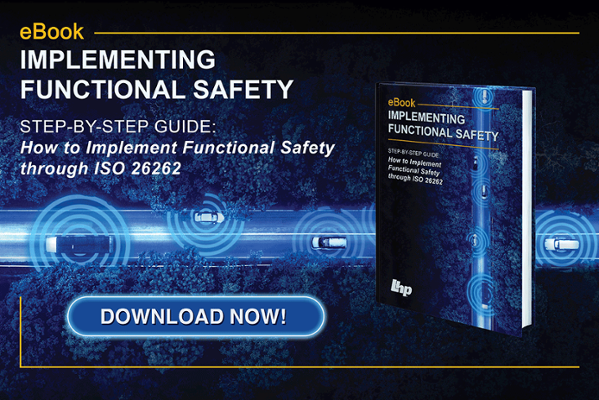Improving Vehicle Safety through Simulated Testing Techniques
Improving driving safety through the reduction in opportunities for human error has been a focus of automotive manufacturers since the 1970s when...
Unlock Engineering Insights: Explore Our Technical Articles Now!
Discover a Wealth of Knowledge – Browse Our eBooks, Whitepapers, and More!
Stay Informed and Inspired – View Our Webinars and Videos Today!
Exploring the future of software-defined vehicles through expert insights.

The ASPICE framework has established itself as a critical model within the automotive industry, recognized for promoting rigorous engineering practices that organizations are expected to follow. This framework has gained widespread popularity among Original Equipment Manufacturers (OEMs) and Tier 1 suppliers, who often rely on ASPICE assessments to evaluate the capabilities of their suppliers. ASPICE serves as a benchmark for engineering excellence, enabling companies to ensure their processes meet high standards of quality and efficiency. The successful implementation of ASPICE practices not only enhances technical capabilities but also plays a crucial role in securing business opportunities, fostering stronger customer relationships, and building a reputation for reliability and innovation.
Since the release of ASPICE 4.0 in late 2023, the automotive industry has been undergoing a period of transition. Companies across the sector have been actively strategizing on how best to migrate to this new version, which represents a significant evolution of the framework. This transition process has involved comprehensive training programs, updating internal quality requirements, and refining processes to align with the new practices introduced in ASPICE 4.0. The industry has also been focused on understanding the nuances of the updated framework and how these changes impact existing practices. Many organizations are preparing for their first ASPICE 4.0 assessments, marking a significant milestone in their journey toward full compliance with the new model. Having recently undergone this process, I’ve gathered some key insights that I believe will be invaluable to others as they prepare for their assessments. Below, I’ve detailed my top five takeaways from the ASPICE 4.0 assessment process.
The German Association of the Automotive Industry, known as Verband der Automobilindustrie e. V. (VDA) provides clear guidance on scoping the assessment. They recommend that the assessment should focus on a core set of base processes. These include project management and all the supporting processes, such as quality assurance, configuration management, problem resolution, and change management. Additionally, depending on the nature of the product being developed, whether it’s a system, software, hardware, or a machine learning model, one or more engineering process groups should be included in the assessment.
The remaining processes, which might include supplier monitoring and other ancillary activities, are considered flexible or optional. However, this flexibility allows for tailoring the assessment to the specific needs of the project, especially if the assessment is taking place early in the project lifecycle. In such cases, the focus can be narrowed down to a subset of the processes, such as project management, quality assurance, and configuration management, alongside the essential elements like system requirements and system architecture. This tailored approach is particularly beneficial in projects that are still in the process of evolving. For instance, if new features are being added that were not part of the initial project scope, it’s acceptable to proceed without a fully defined set of requirements. In such scenarios, the assessment will concentrate on the agreed-upon release scopes, which will then guide the development or updating of requirements, architecture, and other critical components.
The flexibility introduced in ASPICE 4.0 acknowledges the dynamic nature of modern automotive projects, where changes and new developments are constant and ongoing. By allowing for an iterative approach to requirements definition, ASPICE 4.0 enables teams to adapt more readily to changes, thereby improving the overall quality and relevance of the final product.
Another significant insight from the ASPICE 4.0 assessment is the continued relevance of old strategy documents, despite the framework’s evolution. While ASPICE 4.0 has removed the concept of strategies for level 1, these documents still hold substantial value during the assessment process. For instance, when assessors ask questions such as, “What verification methods do you use for system requirements?” it can be more effective to explain your methods by referencing an existing strategy document. These documents provide a structured approach and layout that can help articulate your methods clearly and convincingly.
Walking the assessors through a strategy document allows you to present your verification processes within a familiar and organized framework. It’s beneficial to begin by providing a comprehensive overview of the entire document, offering context and demonstrating how your verification methods fit within a broader strategy. After this initial presentation, you can then delve into specific examples, showing how these strategies are applied in practice. This approach not only makes it easier for the assessors to understand your methods but also demonstrates that your processes are grounded in well-established, documented strategies.
If your objective is to achieve ASPICE Level 2, a level that is now considered the minimum expectation by most OEMs, these strategy documents become even more critical. ASPICE Level 2 focuses on managing and improving processes; having well-documented strategies can significantly strengthen your case during the assessment. These documents help ensure that your verification processes are not only effective but also align with industry standards and best practices. By leveraging these documents, you can provide a clear and cohesive narrative that illustrates how your processes are designed to meet and exceed the requirements of ASPICE 4.0.
Moreover, the continued use of strategy documents reflects the broader principle of continuity within the ASPICE framework. Even as the framework evolves, certain foundational practices remain relevant and valuable. The retention of these documents is a testament to their enduring utility, providing a bridge between past and present methodologies. This continuity is crucial in maintaining a consistent quality of work, even as the industry adapts to new standards and practices.

Defining quality criteria for processes and work products has always been a vital aspect of the ASPICE framework; however, with the introduction of ASPICE 4.0, this requirement has been given even greater emphasis. ASPICE 4.0 has established defining these criteria as a Base Practice (see SUP.1 BP.2: Define criteria for quality assurance), underscoring its importance in ensuring that processes and work products meet the expected standards of quality.
Quality criteria serve as a benchmark for what constitutes a successful process or product. For example, when defining what makes a requirement “good,” the criteria might include clarity, testability, and adherence to a structured description. ASPICE 4.0 encourages the use of notes as a form of guidance. For instance, in Requirements Analysis processes, SYS.2 BP1 includes a note that references standards such as ISO IEEE 29148, ISO 26262-8:2018, and the INCOSE Guide for Writing Requirements. These notes offer a valuable resource for defining quality criteria and ensuring that your processes align with established industry standards.
Rather than reinventing the wheel, ASPICE 4.0 advocates for leveraging existing industry standards and practices when defining quality criteria. Standards such as ISO 9001, IATF 16949, ISO 21434, ISO 19011, IEEE, and NIST offer well-established guidelines that can be adapted to your specific processes and work products. By using these standards as a foundation, you can create quality criteria that are both rigorous and relevant, ensuring that your processes meet the high expectations set by ASPICE 4.0.
The introduction of quality criteria as a Base Practice in ASPICE 4.0 reflects the framework’s focus on consistency and reliability. By establishing clear criteria, organizations can ensure that their processes consistently produce high-quality work products, regardless of the specific project or context. This consistency is crucial in maintaining trust with customers and stakeholders, as it demonstrates a commitment to quality that goes beyond individual projects.
Moreover, the focus on quality criteria highlights the importance of continuous improvement within the ASPICE framework. By regularly reviewing and updating these criteria, organizations can ensure that their processes remain aligned with the latest industry standards and best practices. This proactive approach to quality management is essential in an industry where standards and expectations are constantly evolving.
Exploratory testing has long been a valuable tool in the software development process, and ASPICE 4.0 has recognized its importance by removing penalties for verification processes that cover more than just their direct inputs, such as requirements-based and interface tests. This change represents a significant shift in how testing is approached within the ASPICE framework, enabling a broader range of testing methods that provide deeper insights into the quality and performance of a product.
In previous versions of ASPICE, there was a tendency to focus primarily on tests that were directly tied to specific requirements or interfaces. This approach, while effective, often limited the scope of testing and left little room for more exploratory methods. However, ASPICE 4.0 has introduced new rating rules that explicitly address and encourage the use of exploratory testing. For example, the Automotive SPICE 4.0 Guidelines (2nd edition) include rules that state, “[SYS.5.RL.3] If explorative tests are defined as verification measures, then SYS.5 BP.4 [Ensure consistency and establish bidirectional traceability] shall not be downrated.”
This shift acknowledges the value of exploratory testing, which involves designing and executing tests on the fly as the tester interacts with and learns about the test item. According to ISO/IEC/IEEE 29119-1, exploratory testing enables testers to uncover unexpected behaviors and issues that may not be identified by more structured testing methods. Session sheets are often used to structure exploratory testing sessions, setting focus areas and time limits to ensure that valuable information is captured about what was tested and any anomalies observed. While exploratory tests are not entirely unscripted, they often use high-level test scenarios documented in session sheets to provide a focus for each session.
Preparation is key to a successful ASPICE 4.0 assessment. Ensure that you have examples ready for every statement you make during the assessment. If you fail to prepare adequately, the assessors will choose examples for you, which may not be as favorable. It is highly recommended to conduct a dry-run assessment with your internal quality team before the official assessment. This allows you to cross-check all processes for consistency and identify opportunities to improve interfaces between different processes and methods. By thoroughly preparing, you increase your chances of a smooth and successful assessment.
Undergoing an ASPICE assessment is a demanding process, but it can also be highly rewarding if approached with careful preparation and planning. It is essential to plan the assessment meticulously, ensuring that the necessary time and effort are allocated in the project schedule. Depending on the scope, the evaluation can take at least a week, so it is crucial to align and train the entire team on ASPICE concepts and terminology. Remember that the assessment results are typically valid for one year, so a successful assessment can set the stage for continued success and improvement within your organization.

Improving driving safety through the reduction in opportunities for human error has been a focus of automotive manufacturers since the 1970s when...

In Europe, it’s credibility, in the United States, it’s liability, and for everyone, it should be seen as an AI enabler. A well-defined process is an...

1 min read
How is Automation through AI redefining efficiency and productivity in Engineering? Artificial Intelligence is no longer an experiment or a future...